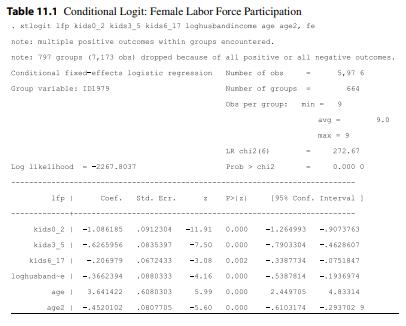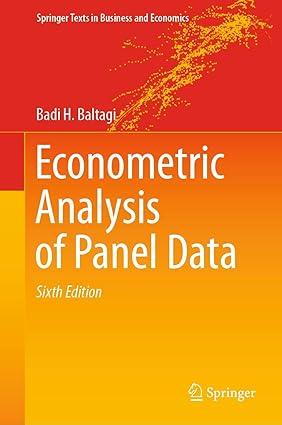This is the empirical example used in Fernandez-Val (2009) and used as example 1 in this chapter.
Question:
This is the empirical example used in Fernandez-Val (2009) and used as example 1 in this chapter. This data is available in Stata as lfp_psid.
(a) Replicate the conditional logit fe results in Table 11.1 in this chapter using xtlogit, fe.
(b) Add fixed time effects to the conditional logit fe in part (a). Test the significance of these fixed time effects.
(c) Using logitfe run the model in part
(a) uncorrected for bias with no time effects.
(d) Using logitfe run the model in part
(a) uncorrected for bias with individual and time effects.
(e) Add lagged labor force participation, so the model is dynamic and run logitfe as in part (d).
(f) Run the dynamic model in part
(e) with analytical bias correction option restricting the trimming parameter to 1 .
(g) Run the logitfe commands with the jackknife options allowing for the six different types of jackknife corrections described in Cruz-Gonzalez, Fernandez-Val and Weidner (2017).
(h) Redo part (a) and (b) using xtprobit, re rather than xtlogit, fe.
(i) Red o parts (c) and (h) using probitfe rather than logitfe.
Example 1:
This is the empirical example used in Fernandez-Val (2009). The sample is selected from waves 13 to 22 of the Panel Study of Income Dynamics (PSID) and covers ten calendar years 1979–1988. Only women aged 18–60 in 1985 who were continuously married with husbands in the labor force in each of the sample periods are included in the sample. The sample considered consists of 1461 women, 664 of whom changed labor force participation status during the sample period. The first year of the sample is excluded for use as the initial condition in the dynamic model. Table 11.1 gives the xtlogit, fe results for the female labor force participation as a function of the number of kids between 0-2 years of age, number of kids between 3–5 years of age, number of kids between 6–12 years of age, log of her husband’s income, her age and age2. The results show that having kids no matter what age reduces the probability of participating in the labor force. The higher the husband’s income and the higher her age, the higher is her probability of participating in the labor force. This probability however decreases with age2. All effects are significant. Unfortunately, these are not the marginal effects. Average partial effects are available using logitfe.

Step by Step Answer:






